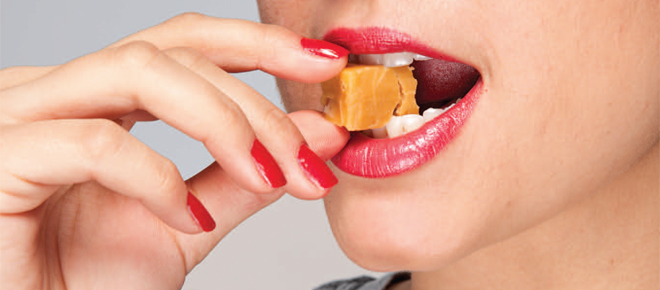Paging Willy Wonka
Searching for innovation from the candy factory
Christie Vuong
Share

Mars bars, 3 Musketeers, Oh Henry!—despite flashy packaging or a new flavour, like a white-chocolate Kit Kat, many of today’s chocolate and candy brands have been around for decades. Snickers was born in 1930 and Life Savers first went on sale in 1912. Hershey’s milk-chocolate bar dates back well over a century.
On Jan. 17, the Pennsylvania-based Hershey Company launched the Lancaster caramel across the U.S., a rich, chewy bite that comes in three flavours: vanilla and caramel, vanilla and raspberry, and caramel. Given its grand name and bucolic packaging, depicting a farmhouse and dairy cow, many consumers might not realize the product is new. Yet the Lancaster is Hershey’s first new brand in 30 years.
Candy and chocolate companies tend to be far more risk-averse than Willy Wonka’s fictional factory, which churned out incredible edible inventions such as lickable wallpaper and everlasting gobstoppers. In reality, innovation in this industry tends to be “incremental,” notes Patrick Dolan, a consumer market consultant at KPMG: We might see a bite-sized version of a tried-and-true product, or a new ingredient, such as cranberries or sea salt, incorporated into an already-familiar bar. (Dark chocolate is increasingly popular, partly because of its touted health benefits.)
Hershey’s has announced line extensions, or sub-brands that bear its familiar name—on Jan. 15, it unveiled a new line of Hershey’s chocolate spreads, a shot aimed squarely at Nutella—but the Lancaster caramel, which doesn’t wear the Hershey’s logo on the front of its package, is entirely new. “Product launches are extremely risky,” says IBISWorld industry analyst Hester Jeon. Soft caramels are an “untapped market” in the U.S., she believes; if it succeeds, we could see an influx of similar products on store shelves.
Today’s behemoth chocolate and candy companies have existed since the early 20th century, making competition fiercely intense. In the U.S., three of them—Hershey’s, Mars Inc., and Nestlé SA—account for 65 per cent of the market, says Jeon. Hershey’s is the biggest, with a 31 per cent share. This helps explain the sluggish pace of innovation: “How creative could you be with this category?” Dolan says. “It’s saturated.” Even so, since the recession, companies have been focused on growth. “We’re seeing innovation in the soft-candy category,” such as gummies and taffies, Jeon notes; that’s partly because demand for chocolate bars is tapering, driven by health concerns, while hard candies have been in the market a long time.
Despite our different landscape, there’s been similar consolidation in Canada, says David Soberman, a marketing professor at the University of Toronto’s Rotman School of Management, who worked in the industry in the 1980s. “When I was working, there were six major firms,” he says. That number has since been whittled down to four: Hershey’s, Nestlé, Mars and Cadbury. “When you reduce players,” he says, “it’s easier to coordinate.” Last year, all four agreed to pay more than $23 million to settle a class-action lawsuit over price-fixing in Canada. (Hershey Canada pleaded guilty, and was fined $4 million.) The Competition Bureau is pursuing a criminal conviction against three companies and their past and present execs, including Nestlé Canada and Mars Canada.
Even so, some smaller brands have flourished by “carving out a niche with unique products,” he says, or promoting their bars as a rare indulgence. Soberman points to Ferrero and Lindt, which appeal to “someone who buys [sweets] occasionally, and doesn’t want a run-of-the-mill standard.” Lancaster, at least to start, is being positioned as a premium item: It won’t be sold up front with the impulse buys, but in the candy aisle.
Although the Lancaster is new, founder Milton Hershey started out making caramels before he became famous for chocolate. As a sign of how much has changed since, Hershey debuted the Lancaster in China, its fastest-growing market, before rolling it out on U.S. shores. The company also has a new Asia Innovation Center in Shanghai to develop and launch new products. There, the Lancaster is a “milk candy,” smaller and harder than the big, chewy American version. Hershey’s, which manufactures all its Canadian products in the U.S. since shutting down its plant in Smiths Falls, Ont., in 2008, tailors its recipes to our tastes, too. “Canadians prefer milkier chocolate with more European-based attributes,” explains spokesperson Anna Lingeris.
There’s no word yet on whether the Lancaster will launch here. But if it succeeds in the U.S., we could see a rush of soft caramels on store shelves, ushering in a new candy age.